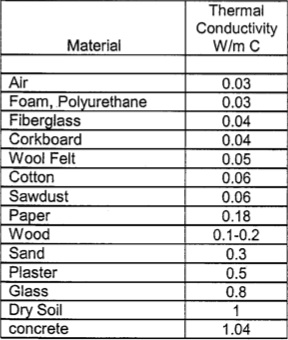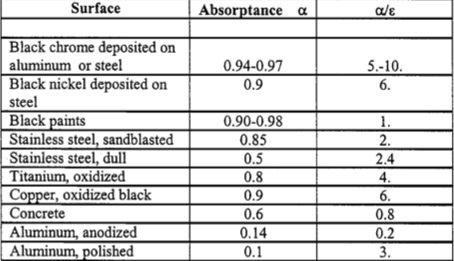Tom Sponheim (talk | contribs) m (Reverted edits by 72.10.102.162 (talk | block) to last version by Tom Sponheim) |
Tom Sponheim (talk | contribs) m (→See also) |
||
| (7 intermediate revisions by 3 users not shown) | |||
| Line 1: | Line 1: | ||
{{GoogleTranslateLinks}} |
{{GoogleTranslateLinks}} |
||
| + | {{Updated|4|19|14}} |
||
| − | |||
| − | [[Solar box cookers]] often make use of |
+ | [[Solar box cookers]] often make use of '''insulation''' in their wall cavities. Studies have shown however that this insulation is not very important since most of the heat is lost through the [[glazing]]. |
[[Image:Thermal_conductivity.jpg|thumb|left|3000px|Thermal conductivity of various materials]] |
[[Image:Thermal_conductivity.jpg|thumb|left|3000px|Thermal conductivity of various materials]] |
||
| − | + | Insulation in solar box cookers with the inner box/outer box construction is usually accomplished by lining the space between boxes with foil. Foil insulation may have patches but the foil should make a complete cover. Wrinkles are no problem if pressed flat. Air bubbles behind the foil make it easier to tear but work alright for insulation. Priorities on the use of limited amounts of foil are as follows: 1) cover the inner oven space including the inner top of the lid around the glazing and the reflector if one is essential, 2) the inside of the outer box and 3) the oven side of baffles. Foil alone is sufficient in many solar box cookers. |
|
For additional insulation, lightly pack the foiled space with any light-weight, clean-smelling, non-toxic substance. Such bulk insulation is packed loosely as it insulates best if quite airy. Yet it is packed sufficiently tight so that it will not settle over time, leaving an empty, uninsulated space at the top. Also, with loose packing the sides of the oven are not forced out. A baffle, foiled or not, helps insulate, in part by preventing settling and in part by blocking the convective flow of air. Baffles, which are sheets of cardboard or other material used to partition the insulation space within each wall, are secured approximately in the middle of the space held in place by insulating filler on both sides. A slanted baffle adds to the structural strength but is not significantly better for insulation than a perpendicular one according to work done by Dr. [[Ed Pejack]]. |
For additional insulation, lightly pack the foiled space with any light-weight, clean-smelling, non-toxic substance. Such bulk insulation is packed loosely as it insulates best if quite airy. Yet it is packed sufficiently tight so that it will not settle over time, leaving an empty, uninsulated space at the top. Also, with loose packing the sides of the oven are not forced out. A baffle, foiled or not, helps insulate, in part by preventing settling and in part by blocking the convective flow of air. Baffles, which are sheets of cardboard or other material used to partition the insulation space within each wall, are secured approximately in the middle of the space held in place by insulating filler on both sides. A slanted baffle adds to the structural strength but is not significantly better for insulation than a perpendicular one according to work done by Dr. [[Ed Pejack]]. |
||
| Line 22: | Line 22: | ||
''[Text for this article was taken from [http://solarcooking.org/kerr.htm The Expanding World of Solar Box Cooking] by [[Barbara Kerr]]]'' |
''[Text for this article was taken from [http://solarcooking.org/kerr.htm The Expanding World of Solar Box Cooking] by [[Barbara Kerr]]]'' |
||
| + | |||
| + | ==See also== |
||
| + | *[[Heat-retention cooking]] |
||
| + | *[[Media:Pejack on solar cooker technology.pdf|An in-depth look at solar cooking]] - ''[[Ed Pejack]]'' |
||
| + | *[[Glazing]] |
||
[[Category:Materials]] |
[[Category:Materials]] |
||
Revision as of 00:10, 22 December 2014
|
Last edited: 19 April 2014
|
Solar box cookers often make use of insulation in their wall cavities. Studies have shown however that this insulation is not very important since most of the heat is lost through the glazing.

Thermal conductivity of various materials
Insulation in solar box cookers with the inner box/outer box construction is usually accomplished by lining the space between boxes with foil. Foil insulation may have patches but the foil should make a complete cover. Wrinkles are no problem if pressed flat. Air bubbles behind the foil make it easier to tear but work alright for insulation. Priorities on the use of limited amounts of foil are as follows: 1) cover the inner oven space including the inner top of the lid around the glazing and the reflector if one is essential, 2) the inside of the outer box and 3) the oven side of baffles. Foil alone is sufficient in many solar box cookers.
For additional insulation, lightly pack the foiled space with any light-weight, clean-smelling, non-toxic substance. Such bulk insulation is packed loosely as it insulates best if quite airy. Yet it is packed sufficiently tight so that it will not settle over time, leaving an empty, uninsulated space at the top. Also, with loose packing the sides of the oven are not forced out. A baffle, foiled or not, helps insulate, in part by preventing settling and in part by blocking the convective flow of air. Baffles, which are sheets of cardboard or other material used to partition the insulation space within each wall, are secured approximately in the middle of the space held in place by insulating filler on both sides. A slanted baffle adds to the structural strength but is not significantly better for insulation than a perpendicular one according to work done by Dr. Ed Pejack.

Absorbance of various materials
The Ed Pejack study ranks bulk insulation materials from poor to best as crumpled styrofoam cups, crumpled newspapers, straw, wool, rice hulls, and feathers. Field tests on this ranking are not complete, however, styrofoam in any form is not recommended because it is fabricated with chlorofluorocarbons which destroy atmospheric ozone. The newer gases substituted in making styrofoam are untested for use around food and should be avoided unless it is firmly established they are safe around food at solar box cooker oven temperatures. When styrofoam was used prior to understanding its role in atmospheric ozone depletion, it was considered unreliable as an insulator as it sometimes melted within the solar box cooker wall resulting in a poorly functioning oven. Where styrofoam was successful, the inner oven wall was relatively thick and sturdy so reduced amounts of heat penetrated as far as the insulation.
Crumpled newspaper has insulated hundreds of successful solar box cookers and is the preferred insulation in many areas. Field work with feathers is limited but seems promising. Loosely carded wool was outstanding in two field uses. Those tests were run with sheep wool, but the texture of some dog wool is indistinguishable. Probably any animal wool would insulate well. Shredded paper, hay and pine needles also have been satisfactory.
Pressed fiberglass insulation serves well. Loose fiberglass batts also insulate well but both present health hazards. Fibers are released while the material is being worked and penetrate the eyes, lungs and perhaps are swallowed. Foam insulation is made with toxic gases which continue to off gas for long periods. For these reasons both fiberglass insulation and foam insulation are not recommended.
Where foil and insulating fill are not available, multiple layers of cardboard either with or without spaces between the layers have produced useful solar ovens. If there are spaces between the layers of cardboard, they may be simply left as insulating air cavities or may be filled with crumpled newspaper or other material insulation. Unless using foil, baffles and lots of air space, a large quantity of insulation is usually needed and can make an SBC very heavy.
To test the effectiveness of oven insulation, heat the oven in the sun until it is quite hot. Then place a hand underneath and on the side beneath the reflector. Shadowed areas do not feel warm in a well insulated oven. If insulation is inadequate, has melted, or has shifted, this can be felt through the exterior wall. If there is question about a side or front area, place something to keep that area in the shade until the test.
[Text for this article was taken from The Expanding World of Solar Box Cooking by Barbara Kerr]
